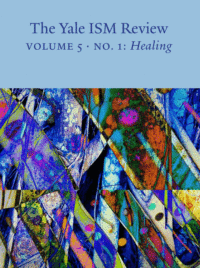Vijay Gupta
“Son, don’t you know any songs we know?”
I had just finished playing Bach’s glorious Chaconne in D Minor, the violinist’s Mount Everest, for about two hundred hospital inmates in San Bernardino, California. The Patton State Hospital was one of the last remaining state hospitals and had a notoriously dark history: according to a 2017 article in The Atlantic, “During the height of the eugenics movement, California sterilized tens of thousands of patients deemed feeble-minded or insane.” Records retrieved from Patton indicate that nearly 20,000 patients were recommended for sterilization from 1919 to 1952.[2]
Many people emerging from incarceration in prisons all over California are dropped off in the heart of Skid Row, at the intersection of East Fifth and South San Pedro streets, known as The Nickel. They step off a Greyhound bus only to be greeted by thousands of people grappling with crime, prostitution, and addiction; and welcomed by demons that have been haunting them and their families for generations.
In late August of this year, Darrell Fields, a guitarist who brought joy to the Skid Row community by deftly covering Jimi Hendrix songs for celebrations at the Los Angeles Community Action Network (LA CAN), died of injuries sustained from being set on fire inside his tent.[3]
For many, Skid Row is the end of the line.
Within walking distance of hip downtown restaurants and galleries and just over a mile from the shining beacon of the Walt Disney Concert Hall, live the people that we think of as the least among us, people we throw away. They are mostly poor and people of color, shattered by lost hopes and broken dreams, recovering from decades of being locked away in cages real and metaphorical. We easily dismiss them as the Other, the bum, the “problem.” They live on the other side of the American Dream and make our glitzy lives a little less glitzy. “Not in my backyard,” we say.
During the past decade of making music in this community, I have found that we ostracize the most fragile and vulnerable among us, because we have, in some way, locked away the most fragile and vulnerable parts of ourselves. The Skid Row outside us reflects a Skid Row within: a place of dark shame, neglect, fear, and our not-enoughness. This is the place we must look if we want to heal. It is the fertile womb of our humanity, the place of our connection. Skid Row is the beginning of that healing, at least for some.
It was the place where I was taught the meaning of a Hindu aphorism I grew up with but always took for granted: Namaste. Namaste, or Namaskar, is a word colonized by well-intentioned hippies and the yoga industry. It is a phrase that I assumed was merely a formal greeting—something found in the sacred texts I chanted as a child. It literally means “I bow to you” and is usually presented with folded hands pressed to the chest.
But the people of Skid Row have taught me the true meaning of this word. Deprived of homes, they nevertheless create a sense of place and community. Abandoned at the terminus of a collective, learned apathy, they nonetheless forge resilient cultures. Stripped of creature comforts, they find their humanity. And they share their lives generously.
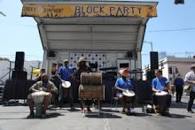 Block Party 2019 – A community celebration in Skid Row, featuring six musical ensembles performing from a flatbed truck. Pictured here: Las Colibrí, an all-women Mariachi ensemble. In collaboration with The Midnight Mission, Block Party served over 2,000 members of the Skid Row community with food, dancing and live music. Photo by May Rigler.
Block Party 2019 – A community celebration in Skid Row, featuring six musical ensembles performing from a flatbed truck. Pictured here: Las Colibrí, an all-women Mariachi ensemble. In collaboration with The Midnight Mission, Block Party served over 2,000 members of the Skid Row community with food, dancing and live music. Photo by May Rigler.
Skid Row has been for me a place of friends, guides and teachers, of community members like Christopher Mack and Brian Palmer[4], musicians whom I met through the Urban Voices Project, a Skid Row community choir. Christopher, a Skid Row outreach worker says, “Skid Row is the beginning for some. Leave a man with his dignity; he’ll come around.” And Brian Palmer says, “Listening is an act of love.” Skid Row is the home of Sir Oliver, a reggae DJ, and Linda Leigh, a vocalist, artist, activist, and community member. Skid Row was the place where the composer Benjamin Shirley found his pathway to recovery and a new spiritual life.
This is a community where I get to make my music—the community of my greatest musical and human teachers. It is a place where listening, paying attention, and showing up wholeheartedly is an act of radical, transformative love.
***
In 2007, in the last free days after my final exams and before graduation as a Master’s student at the Yale School of Music, I auditioned for the Los Angeles Philharmonic. I had never played an audition for a professional orchestra in my life. Although I believed that a career in music, especially in the tradition of Baroque performance practice, was unlikely for me, I thought, what the hell.
They offered me the job.
Joining the Philharmonic was a dream I didn’t even know I could have: a life performing with the greatest living conductors and soloists, an opportunity to play ”the repertoire” with musicians of my teacher’s generation and even a generation older. The musicians adopted me, brought me into their families, guided, taught, cajoled, and accepted me wholeheartedly. As a kid who had often felt unseen, I felt as though I finally belonged.
I met my family in that circle, but I hadn’t yet met my city. Skid Row was as far away and foreign and Other to me as a foreign country. I acquired the learned apathy characteristic of what I thought it meant to live in Los Angeles: I learned to clench my jaw and double-check that my doors are locked at Freeway underpasses and exits; to walk by quickly when someone asks for money on the street, my eyes blankly focused on some far horizon; to not to let my nose visibly wrinkle when I walk past the smell of human excrement.
I had to show up with my humanity first, and my ideas about musicianship second. This was a place to come and own my shadow—to stand fast in my own utterly fragile and vulnerable humanity and connect to others through it.
In 2008, several months into my probation period at the Philharmonic and on my way to earning tenure, I met Nathaniel Anthony Ayers, the brilliant, Juilliard-trained musician who became the subject of The Soloist, a book and subsequent movie by Los Angeles Times columnist Steve Lopez. Many members of the Philharmonic family, including my orchestra colleagues and then-public relations director Adam Crane, became Nathaniel’s bridge of re-connection to a musical life—a community that he thought had thoroughly rejected and ejected him after decades of homelessness on the streets of Los Angeles. He now pushed his instrument-laden shopping cart to the concert hall for rehearsals, concerts—and eventually for violin lessons with me.
Nathaniel’s story as a performer was told far and wide. But for me and my colleagues, Nathaniel became our first guide in the world of Skid Row, and to the vibrant community that exists there. Through Nathaniel, I encountered a community, not just a slum. Nathaniel taught me to walk in that community in humility. This was not a place to celebrate my own virtuosity or expertise; this was a place of dialogue and transformation. I had to show up with my humanity first, and my ideas about musicianship second. This was a place to come and own my shadow—to stand fast in my own utterly fragile and vulnerable humanity and connect to others through it.
When professional musicians, or other Good Samaritans who are dedicated to charitable acts, show up in places like Skid Row, the outside world regards us as heroes. We are celebrated for deigning to come “down” to that neighborhood. It can be an easy and gilded path to self-congratulation, one that is rarely questioned or challenged. I began to see that typical view of outreach as “drive-by Beethoven.”
Audience members and social workers, however, would always look at us a bit warily when we entered with our instruments and music stands—with polished shoes and shiny instruments—wondering when we were going to bail. Even when, in 2011, I tentatively started a non-profit organization dedicated to making music in Skid Row, it was difficult to gain the trust of audiences and clinicians: they smiled brittle smiles. They wondered when we would get tired of them and depart, filled with self-congratulation. They had seen it happen many times before.
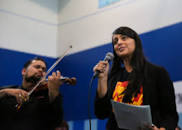
People in places like Skid Row, or even those underserved communities in nursing homes, or Veterans Administration hospitals, become conditioned to think that they somehow matter more on the days when our public consumerism reaches an apex during the year-end holidays. Our guilt consumes us, and we want to “do something for the homeless.” We show up with turkey, a bag of clothes, and temporary good cheer. We’re often making it worse: we reinforce the myth of separation between “us” and “them.”
I have been told that the morning after Thanksgiving is one of the saddest days on Skid Row. The thousands of pounds of free turkey leave six-foot high mounds of rotting trash, a haven for rats. The smell is overpowering. My mentors challenged us: “You really want to help? Come by on the morning after Thanksgiving. Come when you’re not gonna be congratulated for it. Come after the photo-op. Stay. Learn about us.”
***
One time when we took a string quartet by Robert Schumann into Twin Towers jail in downtown Los Angeles, an inmate in the front row said, “You know why I love this classical music? All those composers went through some real shit. Bach was an orphan, Beethoven’s dad beat him . . . and Schumann? Schumann died in a place like this. You can hear it in the music, man.”
He wasn’t wrong. Schumann did indeed die in an asylum. He heard choirs of angels in his head and, at the end of his life, demons. He wrote music in a manic frenzy—at a pace that even outstripped Mozart. “You can hear it in the music, man.” In that moment, Schumann was no longer a marble bust of some dead white guy in a conservatory textbook. We were connected—performer, audience, composer—by that glowing thread of music.
Schumann’s deeply human, fragile, devastating story is what I personally love in him: this is the soul and pathos and realness of the music that I felt for myself as a performer. But I had never imagined that Schumann’s devastated psychological landscape would be a connecting point for an audience member.
Sharing a deeply personal understanding of this composer’s life and music simply would not have happened under normal circumstances. I had even felt a little reluctant to share my own passionate regard for Schumann with my colleagues, masking myself in didactic conversations about technique and intonation and type of vibrato. Yet this man wearing a yellow jumpsuit in a county jail—a man I’ll probably never see again—somehow saw into the core of my musical heart in a way that no paying audience member had ever expressed. We left the jail in tears.
Again I heard the mysterious call and invitation from our audience: get to know us. Stay. Keep showing up.
I started an organization called Street Symphony. We were going to play intimate, monthly chamber music concerts at a Skid Row clinic. The concerts quickly became conversations, and we started to see how that dialogue challenged us to think more deeply—to go beneath the veneer of our professionalism, the bright lights and formal attire, and into the heart of why we became musicians in the first place, and why the composers wrote the music that we performed. We were challenged to think about how a place like Skid Row could ever exist, and why we felt more connected to audiences in clinics and shelters and county jails than we did in concert halls . . . and of all things, why, why it was that we left after experiencing such deep, soulful connection to our audiences, often to never see their faces again.
***
We began to challenge learned apathy in our daily lives. We couldn’t drive or walk past someone pushing a shopping cart on the street and not wonder about their story. What was life like for Malek, or Shugga, or Linda, or Christina, or Will, or Mick, or Kayo? When we talked to affluent friends or donors they would sometimes tell us the stories of their pain or addiction too. We came to wonder about our own histories of trauma and abuse. We began to honor each other more and see each other more clearly.
 Ashe Asé Drummers from the Heart, perform at Block Party 2019. A community celebration in Skid Row, featuring six musical ensembles performing from a flatbed truck. Pictured here: Ashe Asé Drummers from the Heart, a West African drumming ensemble. In collaboration with The Midnight Mission, Block Party served over 2,000 members of the Skid Row community with food, dancing and live music. Photo by May Rigler.
Ashe Asé Drummers from the Heart, perform at Block Party 2019. A community celebration in Skid Row, featuring six musical ensembles performing from a flatbed truck. Pictured here: Ashe Asé Drummers from the Heart, a West African drumming ensemble. In collaboration with The Midnight Mission, Block Party served over 2,000 members of the Skid Row community with food, dancing and live music. Photo by May Rigler.
As our community of musicians grew to encompass musicians from jazz, mariachi, and choral traditions, we began to see the effect of Street Symphony’s programs on the dozens of professional musicians who joined us for programs in county jails and shelters. Musicians would tell us that at Street Symphony programs the audience affirmed them as human beings, asked them how they were feeling that day, and welcomed them to come back. Our former Composer in Residence, Reena Esmail, found that “for people living in Skid Row, music wasn’t a form of entertainment. It was a lifeline.”
Our generous audiences welcomed us into that lifeline, and compelled us to move from outreach into engagement: from that armored one-off “benefit concert” into the willingness to embrace what we couldn’t control. The musical events became as much about our need to transform ourselves as they were about how our music transformed our audiences. We were compelled, by the sheer force of raw humanity and generosity of audiences in clinics, shelters, jails and prisons, to embrace the unexpected, vulnerable mutuality of what it means to be most human in this world: to listen and receive, and to show up wholeheartedly.
***
When I started attending Juilliard Pre-College, one of the first CDs that my dad bought for me was Robert Shaw’s recording of Messiah. I learned every chorus as a boy soprano, delving into this world of Handel as a safe haven, a way of understanding what it meant to be a musician. As I developed a love for Baroque performance practice, I found myself listening to the recordings of Christopher Hogwood, in which he sought to recreate the vocal and instrumental style of the mid-1700s in a more pure form of period performance practice. This was the first time I heard the glorious sound of instruments with gut strings, the A tuned down from a frequency of 440 to 415, and singers like Emma Kirkby.
But, as I learned how to make phrases with a Baroque bow, I wondered how it was that, despite being dedicated to recreating the artistic parameters of the period of Handel, Vivaldi, and Bach, we didn’t take into account the social parameters that gave life to the pieces we venerated. Why had we, in our modern, affluent, conservatory-trained wisdom, chosen to divorce ourselves from the very community-based conditions and practices which made these works root themselves in a cultural consciousness for centuries?
Vivaldi’s Gloria would not exist without the orphaned girls of Ospedale della Pietá. Bach’s Cantatas and Passions wouldn’t exist without the devoted Lutheran communities who knew the hymns he included within them. In the same way, Reena Esmail’s “Take What You Need,” a collaborative work for community choirs and professionals to sing with their audiences and tell their stories, would not exist without the Skid Row community of Los Angeles.
Street Symphony’s annual “Messiah Project” seeks to make a new Messiah for our time. Excerpts of Handel’s oratorio are interspersed with offerings from the Skid Row community and the wide network of Street Symphony’s artists: we start with a set from an all-women Mariachi ensemble. Our Vocal Fellows, members of the Skid Row choir, sing the solos—either selections from Messiah, songs from Broadway musicals, or their own compositions.
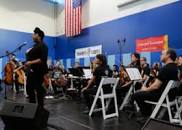 Street Symphony Founder/Artistic Director Vijay Gupta and 2018 Composer-In-Residence Reena Esmail perform Take What You Need, written by Reena Esmail, at Messiah Project 2017. Photo by Kat Bawden
Street Symphony Founder/Artistic Director Vijay Gupta and 2018 Composer-In-Residence Reena Esmail perform Take What You Need, written by Reena Esmail, at Messiah Project 2017. Photo by Kat Bawden
Patrons from beyond Skid Row who come to hear Street Symphony don’t get preferential parking. They walk through the neighborhood guided by the sound of West African drums, before arriving at The Midnight Mission, where they will have a chance to sing the beloved choruses with community members who have attended our free workshops in advance of our final performance in the gymnasium. We sing Leonard Cohen’s “Hallelujah,” because our community asked to sing it.[5]
***
A few years after the event I played at the Patton State Hospital, I couldn’t shake what happened in that room. I had considered my performance in that event a quiet failure, and I kept thinking of what the man had asked me: “Son, don’t you know any songs we know?” What was he really asking for?
Years later, as I looked up the history of “Jesus on the Main Line,” I realized that this elderly black man wasn’t asking me to entertain him; he was asking me to see him. He was asking me to acknowledge that while I stood on that stage, I also had the opportunity to make room for his history to matter. “Jesus on the Main Line” was one of the freedom songs, sung during the Civil Rights marches by Dr. Martin Luther King and his companions as they rallied for freedom.
The issue wasn’t that he didn’t want to hear Bach. It was that he wanted to hear why Bach mattered to me. And it wasn’t even that I should care about “Jesus on the Main Line”; it was that I should care about why that song mattered to him.
So now, when an audience member asks, “Do you know any songs we know?” we respond, “Well, why don’t you share something with us?”
We’ve had women in prison sing some of Adele’s songs, men speak their poetry and tell us about their love of the late Los Angeles rapper Nipsey Hussle, and we’ve made arrangements of Bob Marley for string orchestra and Reggae DJ to perform at Jamaican Independence Day celebrations in Skid Row parks. We learned how to use our expertise to become part of an existing culture—to write a new definition of how we, as classically trained musicians, might be part of making something beautiful with the community we serve.
Before our 2017 Messiah Project, a man who had spent the night in the courtyard didn’t want to come up to hear us play Handel. He muttered something in Spanish about gringo music as he reluctantly entered the hall. We didn’t tell him that we started Messiah with a thirty-minute set from Las Colibrí, an all-women Mariachi ensemble, but he soon found out. As they sang “Guantanamera,” he stood up in the back row and wiped tears from his eyes. He asked a violinist in Las Colibrí, our coordinator Jazmín Morales, how they knew to sing “his song”? He hadn’t heard it live since he left Cuba, and was certainly not expecting to hear “his music” in Skid Row.
This is our performance practice. As artists in our world today—a world filled with growing disconnection, alienation and violence—we serve as bridges, cultural translators, and meaning-makers. As we discard the brittle armor of artistic “product” and embrace the artistic “process” that informs the collaborative power and grace of the music that we love, we provide a pathway to belonging—for ourselves, our patrons, and our audiences. As we move from outreach and engagement into the radically mutual space of exchange, we become part of the creation of new cultures—restorative spaces for us to feel, to heal, to be.

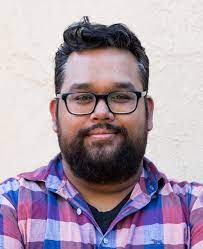 Vijay Gupta is a violinist and social justice advocate. An esteemed performer, communicator, educator and citizen-artist, Gupta is a leading advocate for the role of the arts and music to heal, inspire, provoke change, and foster social connection. Gupta (Yale School of Music M.M. ’07) is the founder and Artistic Director of Street Symphony, a non-profit organization providing musical engagement, dialogue and teaching artistry for homeless and incarcerated communities in Los Angeles.
Vijay Gupta is a violinist and social justice advocate. An esteemed performer, communicator, educator and citizen-artist, Gupta is a leading advocate for the role of the arts and music to heal, inspire, provoke change, and foster social connection. Gupta (Yale School of Music M.M. ’07) is the founder and Artistic Director of Street Symphony, a non-profit organization providing musical engagement, dialogue and teaching artistry for homeless and incarcerated communities in Los Angeles.Vijay Gupta is a 2018 John D. and Catherine T. MacArthur Fellow. Gupta is a passionate and dedicated educator, and an active recitalist, soloist and chamber musician.
- https://www.theatlantic.com/health/archive/2017/01/california-sterilization-records/511718/
- https://www.latimes.com/california/story/2019-08-24/jail-replacement-mental-health-facility-inmate-supervisors-criminal-justice-reform
- https://www.lataco.com/darrell-fields-beloved-guitarist-living-in-skid-row-burned-to-death-while-inside-his-tent/
- https://www.youtube.com/watch?v=eH8-nhIlocA&t=165s (cued to Brian Palmer singing “The People. . .”)
- https://www.youtube.com/watch?v=sw-KyglMNoQ
—
This material is licensed under an https://ismreview.yale.edu
